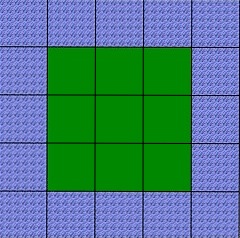Copyright © University of Cambridge. All rights reserved.
'Lawn Border' printed from https://nrich.maths.org/
Show menu
Why do this problem?
This problem presents a good combination of arithmetic, spatial awareness and problem solving for young pupils. At the same time, it is easily extended. It gives learners the chance to choose their own way of representing the lawns and borders, and this means that different representations can be compared.
Possible approach
You could set up the challenge by asking the class to compare the first four images, as is suggested. Encourage them to talk in pairs and perhaps then share their ideas with another pair in preparation for feeding back to the whole class. The ensuing discussion may well necessitate clarification of some vocabulary, such as length, width etc and you may find that, as a whole group, the
children come to adopt certain words to mean certain things in the context of this problem.
As they move on to the main task of investigating differently shaped lawns which use exactly twelve tiles, it would be good to give pupils the choice as to how they represent the lawns and borders. So have a range of resources available such as squared paper, peg boards, square tiles, interlocking cubes, crayons, etc. for them to select as they see fit. As they make each 'garden plan'
encourage learners to explore the following with a partner:
- the number of tiles along the width of the lawn
- the number of tiles along the length/breadth of the lawn
- the number of tiles needed in total to make the lawn
- the number of tiles along the width of the border
- the number of tiles along the length/breadth of the border
- the number of tiles in total that will be needed to make the border around the lawn.
You could collate findings from the whole class on a board or wall so that in the plenary, you can bring the children together to examine the results. With some prompting about how the numbers increase, the children might identify the relationship between the number of tiles needed to make the lawn and the number needed to make the border. Some pupils might be able to explain the
relationship in words.
Key questions
Tell me about why you decided to show the lawn and borders this way.
Tell me about the numbers you've discovered.
Possible extension
Some children may be able to express the relationship in a formula. They could also look at other sizes of lawns, and even isosceles right-angled triangle lawns.
Possible support
Taking photographs of the children's models will help those who find it difficult to commit drawings to paper.



